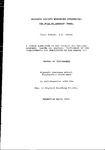BUILDING SOCIETY MARKETING STRATEGIES: THE ROLE OF SERVICE IMAGE
| dc.contributor.author | Robson, Julie | |
| dc.contributor.other | Plymouth Business School | en_US |
| dc.date.accessioned | 2013-10-31T10:01:01Z | |
| dc.date.available | 2013-10-31T10:01:01Z | |
| dc.date.issued | 1991 | |
| dc.identifier | NOT AVAILABLE | en_US |
| dc.identifier.uri | http://hdl.handle.net/10026.1/2488 | |
| dc.description.abstract |
In recent years building societies have experienced dramatic change in the markets in which they operate. Deregulation has provided societies with the powers to enter new and very different markets. Societies wishing to re-work their strategies to exploit the new opportunities however did so with the knowledge that their own traditional markets had also to be protected from new competitors. Deregulation had provided access into the savings and mortgage markets to their natural competitors, the banks and insurance companies. The selection, by societies, of appropriate strategies thus became critical to their future success. Whilst recent studies have investigated the likely strategies to be pursued by societies in response to market change, their findings offer little guidance to societies attempting to re-work their current strategies. Previous studies failed both to consider the appropriateness of all strategic options to different building societies and ignored the likely response of consumers to strategic change. The aim of the research was to identify the marketing strategies most appropriate to different building societies from a consumer perspective. Image was selected as the vehicle with which to study the likely response of consumers to change and thus evaluate the appropriateness of different strategies. Three generic marketing strategies were identified: Differentiation; Focus; and Cost Leadership. The Building Society Image Model was constructed to depict the composition and structure of image as perceived by the consumer. Utilising this model the appropriateness of the three strategies to different building societies was considered. Whilst support was found for both the Differentiation and Focus strategies, the appropriateness of the Cost Leadership strategy was questioned. In particular the applicability of the diversification strategy currently adopted by the majority of societies is challenged. | en_US |
| dc.description.sponsorship | West of England Building Society | en_US |
| dc.language.iso | en | en_US |
| dc.publisher | University of Plymouth | en_US |
| dc.title | BUILDING SOCIETY MARKETING STRATEGIES: THE ROLE OF SERVICE IMAGE | en_US |
| dc.type | Thesis | |
| plymouth.version | Full version | en_US |
| dc.identifier.doi | http://dx.doi.org/10.24382/4578 | |
| dc.identifier.doi | http://dx.doi.org/10.24382/4578 |
Files in this item
This item appears in the following Collection(s)
-
01 Research Theses Main Collection
Research Theses Main


